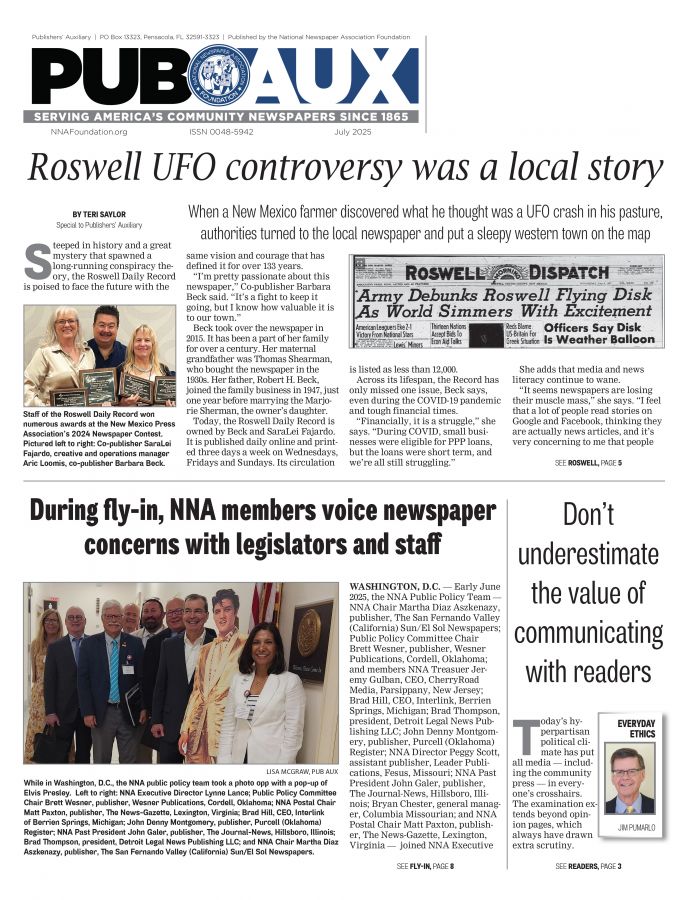Community newspapers scramble in the shadow of the ND oil boom
Nov 1, 2011
Editor’s Note: This is first in a series of stories about newspapers serving their communities in the Bakken Oil Field of northeastern North Dakota, where an oil boom is creating extravagant population growth and an (almost) out of control economic boom. Four publishers were interviewed for this story. Here are the first two:
Black gold. Liquid loot.
North Dakota is booming thanks to a horn-a-plenty of oil in its northwest corner.
While the nation is saturated with news of rampant home foreclosures, employee layoffs, government cutbacks and double-digit unemployment rates, the “Peace Garden State” is bowing under an economy that has grown so fast, the area can’t keep up.
Where newspaper classified advertising is shrinking, newspapers in the oil field are doubling their classified pages. Where reporters, ad directors, and production staff are being laid off in other parts the country, in North Dakota, the newspapers need more workers.
Around the oil fields, fast food restaurants offer $15 an hour to attract employees. Local governments are issuing building permits for new construction as fast as they can approve them.
Oil has been a huge shot in the arm for the state from a tax standpoint,” said North Dakota Newspaper Association Executive Director Roger Bailey. “Unemployment is virtually unknown off the Indian reservations and is in the 3 percent range statewide. The state legislature in early 2011 was dealing with a budget surplus in the area of $1 billion—with a population of 650,000.”
But there is a dark side.
“Expenditures for the state will be rising dramatically in the areas of infrastructure, mostly for deteriorating roads and increased law enforcement,” Bailey said. “A special session of the state legislature will be held in November to address these issues. Nobody really understood how much of an effect this was going to have on the state and its people. Only now are we getting a firm hand on the situation.”
People traveling out west to seek jobs and better lives should take their own housing with them. There are not enough available places to live for the scores of new workers in the area, and the housing that is available is offered at astronomical prices.
Accident rates have tripled. Schools are overflowing, and some people have compared the amount of traffic to volumes seen in major metropolitan areas.
Four community newspapers publishers and editors located around the Bakken oil field, a shale formation spanning 14,000 square miles in North Dakota, Montana and Canada, were interviewed.
There are no absolute figures on the amount of oil waiting below the surface, but estimates range from 4 billion barrels to 20 billion barrels. The controversial method of frakking horizontally deep below ground rather than past methods of drilling straight down, enables oil companies to extract large volumes for many years.
The publishers said they believe the oil boom will last a long time.
CROSBY JOURNAL/TIOGA TRIBUNE
“North Dakota is our domestic Saudi Arabia,” Steve Andrist said. “The oil reserves here are even more significant than earlier geographic surveys predicted.”
Over the last couple of decades, parts of the state were on the decline, said Andrist, publisher of the Crosby (ND) Journal and the Tioga Tribune, newspapers that have been in his family for three generations.
North Dakota is a largely agricultural state, where technology has improved farming efficiency, and reduced the reliance on human resources.
“This has led to a population decline,” Andrist said. “We’ve watched young people move elsewhere, because there are not many jobs here. And this has led to a loss of economy and a population decline.”
What a difference a few years and a large oil reserve make.
People are returning to northwestern North Dakota—in droves.
“For the first time in 50 or 60 years, our state’s population is increasing,” Andrist said. “At first we thought we had found the answer to turn our economy around. But after a couple of years, the honeymoon ended.”
North Dakota, which makes the news each summer because of river flooding, is now flooded with oil workers, big rig trucks, manufacturing outlets and job openings.
The state’s local businesses, government and infrastructure can’t keep up.
“Today, anyone who wants a job can find one,” Andrist says. “Reports that unemployment is at 2 percent are too generous. If there is anyone here who doesn’t have a job, then something is wrong.”
The Crosby Journal and Tioga Tribune are bursting at the seams with legal notices, advertising and news.
“In the de-population days we were scrambling to find stories, and we ran a lot of features. Now we are wishing for the luxury of time so we can do more features,” Andrist said. “We are spending all of our time covering development stories: planning, zoning, water, roads. So many issues.”
Heavy trucks traveling along the rural roads have torn up the asphalt. Housing rents are hovering between $2,000 and $3,000 per month for homes occupied by several oil workers rooming together.
“We cover more traffic related issues and crime such as bar fights and personal assaults,” Andrist says. “Our health care system is struggling to keep up with the demand, as well as handling injuries caused by oil rig accidents that they have never seen before.”
On the advertising side, Andrist has seen an uptick in public notices and classified advertising.
“We have always had a very small classified advertising section, just one page, which was a joint section shared by our two newspapers. Now we are at two pages of classifieds every week,” he says. “We have public notices published because of zoning and annexation hearings we never used to have.”
Andrist has had to go up two pages overall in his newspaper, and advertisers are requesting more color, “which we really like,” he said.
“I feel kind of self-conscious when I go to NNA meetings and talk with publishers cutting budgets and laying off people,” Andrist said. “For us, the last two or three years has been our best ever in this business.”
WILLISTON HERALD
Williston is bursting at the seams.
“There are tent cities springing up and campers all over the place,” said Mitzi Moe, publisher of the Williston (ND) Herald. “Rents are also exploding. Apartments that rented for $700 went up to $1,000 last year, and this year they are at $2,000.”
People are living in tents, in campers and in residents’ basements. They also are renting rooms and living in housing developments called “man camps” located on the outskirts of the small towns around the oil field.
“Hiring people is next to impossible,” Moe said. “We are running short of staff in every department: news, advertising and circulation.”
Moe, herself, was working the front desk during a conversation with a reporter.
“It has been an experience,” she admits. “I am learning customer service all over again, and learning what my staff goes through day to day. Everyone is pitching in, too. Our circulation director is helping to sell ads. Our classified advertising people are taking on accounts. There is so much involved; we’re taking it day to day.”
Moe, who has lived near Dallas, compares the jammed roadways around Williston to Dallas’ metro traffic.
“We’re not prepared for this. We don’t have the infrastructure,” she said. “Williston is a tiny little town. We have one Walmart, two small home improvement stores, a JC Penney. Yet in the second quarter of the year, we beat Fargo, ND, in sales tax collections.”
In 2009, Williams County issued 447 building permits. In 2011 so far, the county has issued nearly 2,000. Mobile home permits have doubled in the past few years, from 627 in 2009 to 1,108 in 2011, noted Moe.
“Our advertising has increased tremendously,” she said. “Our help wanted classified display ads are generating dollars comparable to our display dollars.”
The Williston Herald is a six-day-a-week daily, owned by Wick Communications. In a normal week, the newspaper published two sections just two or three days a week. Now the newspaper has two sections every day.
Moe also publishes a weekly total market publication and has started a new monthly magazine about the oil industry called “Talkin’ the Bakken.”
The four-color, glossy magazine contained 18-24 pages when it first came out.
“Today we are averaging 80 pages monthly,” Moe said. “Our September 2011 issue had 104 pages. October will have 80 pages.”
Her newspaper employees produce the magazine, in addition to their daily newspaper duties, with no extra help or staffing.
“There’s no extra staff to be had,” Moe said. “Our folks are doing an excellent job.”
Moe’s next frontier is distribution to the man camps.
“The camps are very nice, sort of like barracks, and each resident has his own room,” she said, adding that she is looking for ways to circulate her paper there.
She and her staff have reported on these camps, running regular features on the men who live there.
Although her job has become stressful, it is not without its rewards.
“There is so much going on now,” Moe said. “I am lucky to have a wonderful managing editor, who does a great job with our staff, and I love to see the excitement in young journalists’ faces when they have an opportunity to cover so much breaking news.”
Teri Saylor is a freelance writer in Raleigh, NC. Contact her at terisaylor@hotmail.com.






